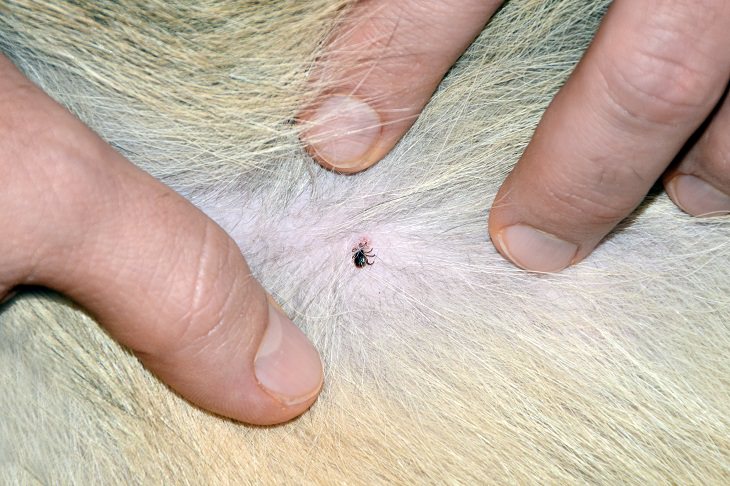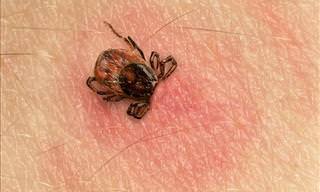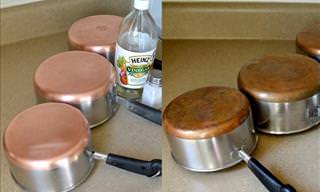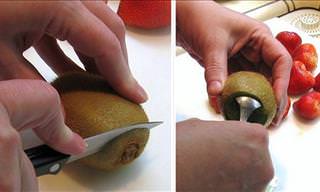
Our beloved cats and dogs love playing outside just as much as we do and, just like us, they are susceptible to picking up the odd tick every now and again. Therefore, after your pet has finished playing outside, you should check them over thoroughly as ticks carry the nasty illness known as Lyme disease.
Dr. Lee Herold, from DoveLewis Emergency Animal Hospital, says: “Ideally, pets should be checked for ticks anytime they’ve been outside, especially if they’ve been out hiking or walking in wooded areas or tall grass. Over the past three decades, cases of Lyme disease have increased and spread across the U.S., meaning vigilance during spring, summer, and fall will be key to your pet’s health.”

Ticks can hide in your pet’s fur, especially if they have a thick coat. To do a thorough check, run gloved-fingers over the top of their head and all over their body so that you can feel if there are any tiny bumps.
You will want to pay extra attention to the parts of your pet that generate the most heat as ticks love warm places. So, this means their tail, chin, face, between their toes, the inside of their ears, and armpits.
If you feel a bump, you’ll know it’s a tick feeding on your pet if you see a tick butt sticking out – it will usually be brown or black in color. If the tick is engorged with blood, it will be a light gray color. You should remove the tick immediately and dispose of it properly in order to keep you and your pets safe.

1. Put on a pair of gloves so that your skin does not come into contact with the tick. Next, take a pair of tweezers, hold them horizontally, and grab the tick up as close to your pet’s skin as you can without hurting your pet.
2. Pull the tick straight up and try to remove it in one swift motion. Try not to move, jerk, or twist the tweezers when you’re removing the tick as this could lead to parts of the tick being left in your pet.
3. Some people like to flush the tick down the toilet or burn it with a lighter once it has been removed. However, some vets recommend that you place the tick in a plastic baggie or clean empty pill bottle and bring it to your vet so that it can be identified and tested should your pet start to show signs of tick-borne illness.
4. Place some rubbing alcohol or iodine rinse on the bite to disinfect it.
N.B. If your pet starts to show lameness, lethargy, and loss of appetite, you should report it to your vet immediately.
Source: shareably
Images: depositphotos

Quiz: Are You Prepared to Take On the Great Outdoors?
Love going hiking and camping? This test will determine just how ready you are to take on the perils of the great outdoors.
 10:32
10:32
This is How Mountain Goats Defy Physics and Gravity
They're known to be able to defy the laws of physics, and today we'll discover exactly how they do that.

Captured in Motion: The Flight of the...Dog
These photographs are so intense, the dogs in them seem to look you straight in the eye!

Lyme Disease: Symptoms, Treatments, and Prevention!
Lyme disease is spread by ticks. This is everything you need to know about this unpleasant disease.
 3:07
3:07
Cows are the Cutest, But This One is Something Special
He acts just like one of the family dogs! And the best part? They're all best buddies!
 10:19
10:19
Lift Your Spirits With These Animal Rescue Stories!
Forget about the damsel in distress. This time, nature calls, and we must answer!

Have You Been Eating Bananas Wrong Your Whole Life??
There are so many food items we have been eating the wrong way our entire life. Here are the right ways to eat these 10 foods.

31 Genius Uses for Lemon That Are Worth Knowing
Did you know that lemons could help you clean, cultivate, and even give first aid? Discover 31 brilliant uses of lemon....

Collection: 12 Full Guides to Pet Care!
What can't we feed them? How do we know they're sick? What does their behavior mean? All this and more you'll find in these guides.
 8:26
8:26
How to DEEP CLEAN Your Windshield Perfectly
Clean windshields are not just nice to looks at but also important for your safety! So if it's time to give your windshield a scrub, check out these important tips.

Boost Your Happiness in These 22 Small, Easy Ways
Do these little things every day, to make you feel happy.

6 Simple and Practical Tips To Organize Your Kitchen
A well organized kitchen is the first step to a gratifying cooking experience

Look At the Eyes: How to Tell When People Are Lying
According to NLP, one can know whether a person is lying or not only through the eyes. Learn how to do this with the help of this guide ...

We Bet You're Not Aware of These Real-World Facts
Don't miss this random collection of interesting real-world facts from the world over that you are unlikely to have heard before

NEVER Do These 7 Things When Using a Power Strip
These are 7 safety tips you should always follow when using a power strip to avoid disaster

10 Wise Plumbing Tips From a Professional Plumber
Here are ten brilliant tips that can save you heaps of time and money when you've got plumbing problems at home.

How to Distinguish between Chinese, Korean, and Japanese
After reading this guide, you'll be able to tell the Chinese, Korean, and Japanese languages apart!

NEVER Put These 5 Things in the Microwave!
Some things should never go in the microwave, because of the health dangers. Here are 5 things you should keep out of the microwave.

6 Great Benefits of Waking Up Early
Do you promise yourself that you'll wake up early the next day, but at the moment of truth you hit the snooze button? Stop this with these 11 tips!
 4:12
4:12
The Genius Ways to Wrap Awkwardly Shaped Gifts
To save yourself a little money, and to help you get a tad more creative this festive season, we've got the perfect solution for you.

Keep Food Daisy Fresh: Here's the Secret
Food wastage is always a shame, and that's why we should all do our best to avoid it as much as possible.
 8:03
8:03
Testing 10 Amazon Phone Gadgets: Are They Any Good?
Are these phone gadgets as good as advertised? Let's check it out.

Banish Your Skin's Pimply Blemishes with These 8 Remedies
You thought and hoped you'd left those acne ridden days behind you. Well with these 8 home-remedies you may finally be able to enjoy pimple free skin.

All About Women: 24 Facts About the Fairer Sex
These fascinating facts will probably surprise even our female readers. We gathered 24 facts that we best you've never heard about, and each of them will make you understand yourself and women a bit better.
 4:45
4:45
Whoa! I Never Knew an Empty Plastic Bottle was So Useful
When you've finished with the contents of a plastic bottle, don't throw the bottle away as it can be used for so many different things.

I Use Grandma's Old Trick for Cleaning Copper Pots
This is how to easily clean your copper pots.
 8:01
8:01
Why Your Consumer Brand Loyalty Can Backfire
It happens to all the consumer goods you can imagine...

8 Everyday Activities That are Damaging Your Spine
Here's a list of everyday activities that harm your spine.
 7:23
7:23
Discover 7 Ways to Make Your Home Smell Great
Check out these seven wonderful ways to keep your home smelling clean and fresh without breaking the bank!

Salt Has Many More Uses & Benefits Than You Ever Imagined
Salt has been in use for thousands of years, and also happens to have thousands of uses. Here's a selection of them that you probably weren't aware of before.

These 15 Surprising Cucumber Uses Will Come in Handy
Cucumbers are a very healthy addition to any diet, but they also have many other great uses that you should know about. Here's 15...

I Bet You Never Realized How Useful Coffee Grounds Can Be!
Hold it! Don't throw away those old coffee grounds of yours - they have more uses than you can imagine. Read this post for 19 ways to use old coffee grounds.

Keep Spiders Out of Your Home with This Helpful Guide
Here are nine effective ways to keep spiders out of your home:

These Life-Changing Tricks Will Make Your Scalp Less Oily
We will show you how to make your hair produce less oil and give handy tips and DIY tricks that can help reduce the appearance of oily hair
 6:11
6:11
There's a Secret Trick to Understanding Chinese...
This brilliant lecture will teach you the basics of Chinese

Did You Know That Going Bald Can be a Good Thing?
Although for many men, going bald is their worst nightmare, it's actually associated with numerous advantages. Here are 8 to lift your spirits.

Our Complete Guide to Peeling Fruits and Vegetables!
Each fruit and vegetable has a different way of being effectively peeled. Our guide will teach you the very best methods!

You Should be Growing These 10 Healthy Herbs at Home!
Make your diet a lot healthier by growing these healthy and delicious herbs.

How Woodworking Can Create Additional Revenue for You
The best woodworking business courses teach everything from basic woodworking techniques to advanced marketing strategies.

Baby Oil Can Do Things You Never Even Considered!
Baby oil is usually used to keep your baby's skin soft, but in the next article, you'll get ideas for six more effective and surprising ways to use it.

13 Ways to Make Your Shoes More Comfortable
These tips will help you adjust your shoes to your feet, and even enhance them to prevent issues like wetness, squeaking, wrinkling, or pain.

How to Increase Water Pressure in Your Shower: 9 Tips
Is the water pressure really slow in your shower? Here’s what you should do to improve it.

STOP! Before You Throw Your Egg Shells, Read This...
Egg shells have a plethora of useful properties.

7 Japanese Secrets to Staying Slim and Healthy!
The Japanese have their own ways of maintaining their weight.
 13:21
13:21
A Word from Warren Buffett: Investing for Beginners
Unpack the genius of Buffet's philosophy and get a chance to understand the financial world through his eyes. Tune in, absorb, and let your financial journey flourish.

Orange Peels: Read Our Full Usage Guide!
I have at least 45 good reasons for you not to throw those orange peels away. They're really helpful and healthy in so many ways!
 13:00
13:00
Should You Choose or Avoid Copper Pans?
Copper is a great antibacterial metal. Why then don't we all cook in it? This video will help you decide.


